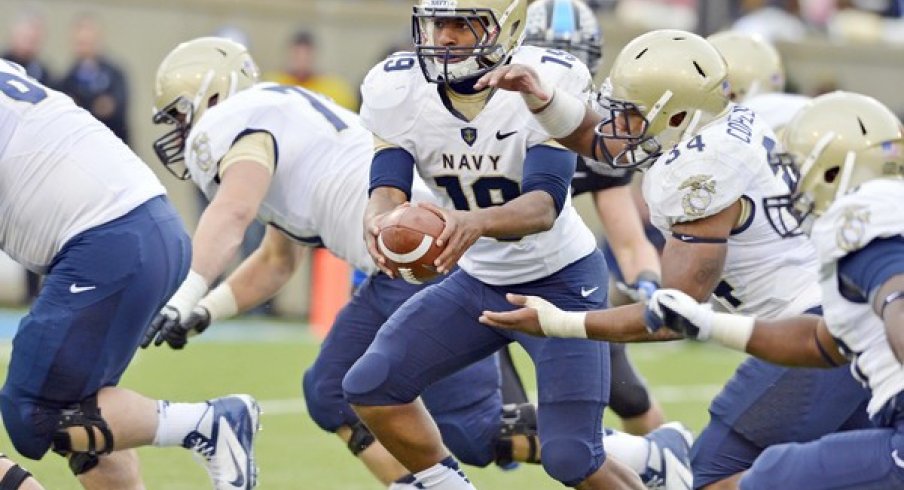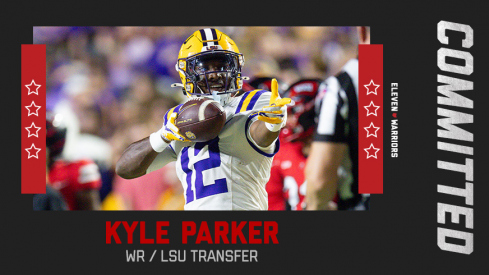Coaches are nervous creatures by nature. It doesn’t matter if the next opponent is Alabama or Massachusetts – they’re going to have an anxious week. But Navy of all teams tends to make coaches more nervy than usual.
Why Navy? Because the Midshipmen run a vaunted triple-option offense that incorporates cut blocking. When the ball is snapped, unpredictability always reigns supreme. With Navy, it does and it doesn’t. A run play is all but certain, but who will get the ball? Options are plentiful.
Even Navy quarterback Kennan Reynolds is out of the loop until he sees which way the defense goes and whom it pursues. According to head coach Ken Niumatalolo nothing is predetermined. For more than a decade, Navy’s offense has become the football program’s identity.
“It’s our calling card,” offensive coordinator Ivin Jasper said. “It’s what Navy football is known for.”
The Midshipmen haven’t won a national championship since 1926 and the last Heisman Trophy came in 1963. Over the past half century, the Navy head coaching position has become one of the toughest jobs in the country. The odds are tilted heavily against Navy – military commitments, stringent academic requirements and a long stint away from the college football spotlight.
Navy doesn’t haul in recruits with stars next to their names and they aren’t as big, fast or strong as opponents. Yet, Niumatalolo has won 62 percent of his games (49-20 over six years) and guided the Midshipmen to five bowl games. A portion of that success is due to their unique offense.
“I think it’s very confusing to a defense,” former quarterback Ricky Dobbs said in 2009 when Navy played at Ohio State, losing 31-27. “Sometimes it's confusing to us. At first, I was like, ‘Man, I wish we ran something different,’ but I think this offense can work any place as long as you get the guys tuned it to where they sell out for it.”
For Navy, leveling the playing field means baffling the competition, not loading up on the best players in football-rich states. When Ohio State’s defensive line – one of the best in the country – stares across the line of scrimmage at five much smaller football players, the reality sets in that trickeration and misdirection are needed.
Niumatalolo believes more teams should adopt the abnormal style – at least those that already face an uphill climb. The equalizing power is evident each time Navy takes the field. It regularly beats FBS programs and has defeated Notre Dame three times since 2007.
There’s a psychological factor involved when playing Navy, almost like golfers in the U.S. Open. The Midshipmen wear down opponents by running, running and running. And they convert third downs at a high rate every seasons. In 2013, Navy ranked sixth nationally, converting more than half of its third downs.
“In my opinion, this is the most difficult team we play,” Indiana head coach Kevin Wilson said last season. “The reason being, everything we do defensively, throw it away and don’t do it again.”
The Hoosiers had just 10 possessions in a 41-35 loss to Navy. Reynolds torched Indiana for 127 rushing yards and three touchdowns. As a team, the Midshipmen totaled 444 rushing yards and five touchdowns on the ground. Reynolds completed two passes – one for 47 yards and the other for 24 yards.
“Your errors are more exposed and more critical,” Wilson said. “It’s like at-bats – you don’t get as many swings.”
Navy returns six players who rushed for at least 200 yards last season, including Reynolds, a 1,300-yard rusher. It also has six players who averaged more than five yards per carry. Navy scored 50 rushing touchdowns in 2013.
Asked why Navy’s run game is so effective when defensive coordinators know what’s coming, Niumatalolo kept it simple: Because it’s sound.
“It’s like the pick-and-roll in basketball,” he said. “John Stockton and Karl Malone did it for years. I think that’s what option football is. It’s not a gimmick, it’s based off numbers, it’s based off angles and it’s based off what you’re doing.
“Some guys talk about halftime adjustments. We’re making adjustments after the first couple plays. We’ll try to see who you’re hurting us with and then counter. You have to get to the game and make adjustments based off that. That’s why I think option football’s worked. It’s based off principles.”
Said Jasper: “The defense knows what we’re going to do. It’s a matter of us out executing their defense.”
Those principles led to 4,230 team rushing yards last season – good for a 5.5-yard per rush average. Navy’s 325 rushing yards per game were second only to Auburn. For most teams in the country, it points to a good running back and elite dual-threat quarterback. At Navy, it’s all backfield all the time.
If you want to find selfless football players, just watch a Navy game. Wide receivers spend upwards of 80 plays blocking – not catching passes. Being a wide receiver for the Midshipmen means more blocking than Ohio State’s tight ends. Service academies have the luxury of being filled with selfless leaders.
“All these kids have pride in what we do and they believe in it,” Jasper said. “We’re not going to change. We’re going to go into every game to try to establish what we do on offense, not let people dictate what we do.”
They certainly don’t allow that to happen. With defenses keying on the run, the Midshipmen threw all of 146 passes in 2013. Just over half of those attempts were completed for 1,117 yards with eight touchdowns and four interceptions. Only one team – Army – ranked lower passing the ball.
“The wide receivers in our offense epitomize who we are,” Niumatalolo said. “They’re unselfish, they’ll do their job, they aren’t worried about accolades. It’s refreshing to coach guys like that. They are good people.”
Perhaps the most unforeseen of all statistics attached to Navy’s offense is the lack of turnovers. Last season, the Midshipmen tied for the fewest turnovers (10) in FBS. Jasper believes it comes from nothing more than discipline, an area Naval officers are quite familiar with.
“There’s a standard we have as an offense in taking care of the football,” Reynolds said. “We know that being undersized and not as athletic as other teams, giving up the ball would really hurt us. To even have a chance to win the game, we have to take care of the football.”
The first test of 2014 could be the biggest of the entire season.


